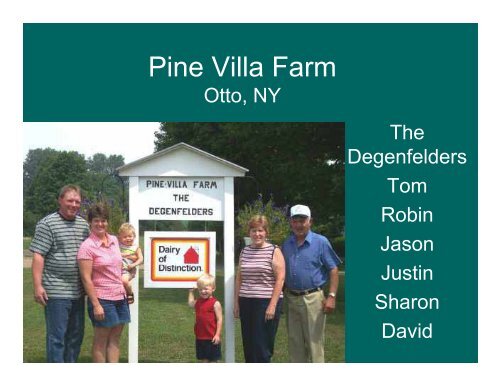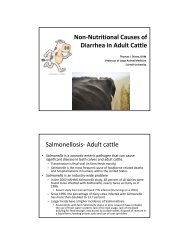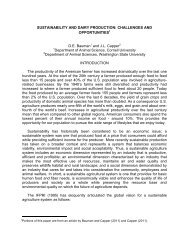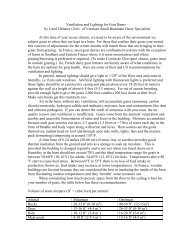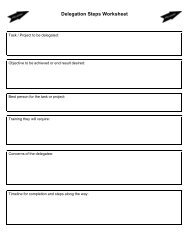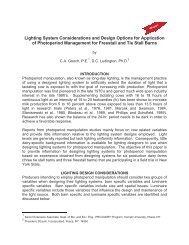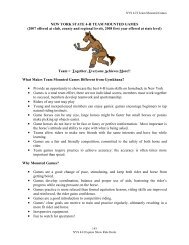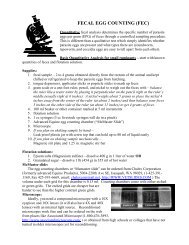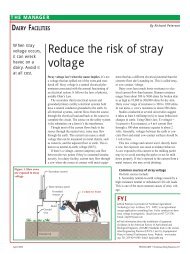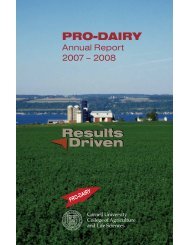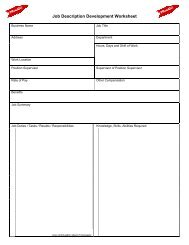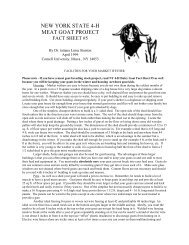Pine Villa Farm Otto, NY
Pine Villa Farm Otto, NY
Pine Villa Farm Otto, NY
Create successful ePaper yourself
Turn your PDF publications into a flip-book with our unique Google optimized e-Paper software.
Degenfelder’s Family and <strong>Farm</strong> Goals• Staying small but profitable• <strong>Farm</strong> to be debt free– <strong>Farm</strong> must support itself and our family• Provide funds to retire early (55)– Don’t plan to use farm assets to fund retirement– Continuously investing outside the business• Provide opportunity for children to learn workethic while giving them a chance to be kids– Want children to have opportunities beyond the farm• Enjoy farming
Historical Perspective• 1996 – Started farming on rented farm in ErieCounty– Bought cows– Rented equipment by the hour• 1997 – Purchased some equipment• 1998 – Began looking for farm with adequatefacilities and land base to be viable for ourfarming career– Urban/sub-urban sprawl– Competition for land with neighboring well establishedfarms– Landowner’s plan for their children to build homes onthe farm
Historical Perspective• 2000 – Purchased farm in North <strong>Otto</strong>– Improved labor efficiencyi– June – moved herd– Switched to Ag Bags from tower silos & dry hay– July to October – 1/3 of milking herd died• Stress of move/poorly ensiled forage– Bought unloaders & stored corn silage in towersilos• 2001 - Put all forage up in tower silos– Tried baleage on one field of hay that fall
Historical Perspective• 2002 – All baleage; stopped choppinggrass– Fall – tried grazing g milking herd– Tried custom harvest of corn silage• 2003 – Implemented managed grazingg• 2004 – All corn custom chopped• 2005 – Used pasture more intensively forbred heifers and dry cows– Reduced pasture use for milking herd
<strong>Pine</strong> <strong>Villa</strong> <strong>Farm</strong> TrendsYearNumberof MilkCowsMilk Soldper CowTotalForageAcresForageAcresper CowCornSilageTons/AcreHay DryMatterTons/Acre2002 90 17,443 260 289 2.89 182003 90 18,337 260 2.89 18 3.1*2004 104 17,547 280 2.69 18 2.72005 108 19,228 280 2.59 20 2.1 *** Did not take 4 th cutting because first 3 cuttings yielded plenty of forage**Took 5 cuttings due to dry conditions causing low yields early in season
Results• Updating equipment regularly• Investing off the farm each year• Retiring i debt very rapidly
?Questions?
<strong>Pine</strong> <strong>Villa</strong> – Feeding System as Part of the Whole
Ration Objectives• Looking for maximum components yieldrather than pounds of milk• Maximize intake of quality forage• Use quality forage to grow heifers– No grain from 8 to 22 months of age
The Right Tool for the Job
<strong>Pine</strong> <strong>Villa</strong> 2005 Forage Lab Results –Key Feeding and Storage Quality FactorsForage DM% NDF%GrassNDFD30hrSol. PNEL% of NDF CP% % of CP MCAL/LBRyegrass Baleage 25.7 49.4 17.3 47 .622 nd Cutting Baleage 29.5 44.6 24.4 58 .663 rd Cutting Baleage 35.2 51.5 18.4 56 .643 rd Cutting Dry Hay 91.9 54.3 21.0 27 .605 th Cutting Baleage 28.8 42.1 25.8 55 .655 th Cutting Baleage 35.6 44.7 19.7 65 .72Corn SilageBMR 34.7 38.7 60 9.0 48 .81Highly Digestible 29.7 43.8 50 9.6 52 .73
Don’t Wrap Crap!!• If you don’t want to feed it to your cowswhy feed it to your heifers
?Questions?
<strong>Pine</strong> <strong>Villa</strong> – Crops as Part of the Whole
Achieve Best Forage QualityEach Season Allows
SoilsCorn Acreage• Chenango ChannerySilt Loam, Fan• Mardin Channery SiltLoamHay Acreage• Rhinebeck Silt Loam• Niagara Silt Loam• Volusia Channery SiltLoam
Soils & Topographic Maps• Soils map
Crop Production• Match crop to soils & elevation• Limited ability to rotate crops• Soils dictate t grass species & cuttingmanagement strategies employed on fieldby field basis• Must fertilize for quality forage production• Grazing reduces manure availability forcropped fields
What We Use to Get Job Done• Corn silage– We do soil prep• 5 bottom mold board plow or chisel plow• 20’ disk & 25’ Cultimulcher– Custom sprayed, planted & harvested• Hay crop– 11’ discbine, two row tedder, 12 wheel v-rake– Claas 250 Roto-cut round baler (4’x4’ bale)– 3 bale wagons – hold 32 baleage or 58 dry– H&Sin-line bale wrapper
What I look for in Corn Varieties• Early on– Standability– Days to maturity– Cost of seed• Now– High whole plant digestibility– Low fiber– Willing to pay for these qualities
Hay Crop Strategies• Rely on grasses• Manage fertility based upon the season• Timely harvest– Cut buy the calendar• 30 day interval– Aggressive cutting practices• Reduced weed population
Criteria for Fertilizing Grasses• Weather• Forage inventory– 2003/2004 - plenty of moisture• Lots of feed• Less need for fertilizer use• Grasses yielded less protein– 2005 – very dry• Short crop – still kept up with harvest schedule• Used extra fertilizer after each cutting to stimulategrowth
?Questions?
<strong>Pine</strong> <strong>Villa</strong> – Harvest System as Part of the Whole
Harvest System
Harvest Strategy• Group fields for harvest– 20 to 30 acres each day– Location, grass species, feeding group• Process– Mow in afternoon– Rake 2 or 3 rows into 1 during night or early morning– Bale mid to late morning; depending upon moisture &weather conditions• Adjust ground speed for windrow size & moisture to get auniform, solid bale– Wrap as soon as possible• Depending upon labor availability• Always wrap the same day baled
Pasture• Advantages– Flexible system– Reduces labor in barn– Provides healthy cowenvironment– High quality feed; ifmanaged properly– Reduced cull rate• Disadvantages– Weather– Possible lower milkcomponents– Quality varies day today– Hard to keep rationconsistent– Requires back-up feedsource (extremeweather)
Baleage• Advantages– Unlimited storage– Separate by fields &cuttings– Flexible - harvest wheneverweather allows– Less leaf loss than dry hay– Fewer people required thanfor chopping– Cow health – length of cut– Smaller equipment neededd• Disadvantages– Plastic – cost, disposal, &holes– Possible lower feed intake -bulky feed– Not economical for largequantities of forage– Wildlife damage to wrap– Less uniform feed
Custom Hire• Minimize investment in little used machinery• Allows timely hay harvest• Extra labor is part of the deal• Faster harvest yields more consistent feed– 4 to 5 days compared to 10 to 14 days when we did itourselves• Bring equipment for filling & packing bunk• Harvest risk managed with variety selection– All corn planted in one day – select different daylength corn to ensure adequate moisture at harvest
?Questions?
<strong>Pine</strong> <strong>Villa</strong> – Storage System as Part of the Whole
Measures of Success• Before Change– 58 to 60 lbs. per cow– 3.84 to 3.87 fat test– 3.0 to 3.1 protein test– Forage:Grain = 58:42• With New Feed– 62 to 65 lbs. per cow– 4.0 to 4.22 fat test– 3.2 to 3.3 protein test– Forage:Grain = 62:38– Dropped• Rumensin• 200 to 250 Lbs. graindaily• 2 bags energy boosterper week
$$ Savings & Earnings $$With 110 cowsCoop avg. base milk price Our base milk price$14.04 $15.68Reduced costs --- $1,265 per monthMilk Increase4.5 Lbs. per cow per day12,960 pounds = $2,000 per monthChange in Net Income = $3,265 per monthAnnual Potential Change in Profit = $39,180
Storage11.05 Lbs/Ft 3Management6.61 Lbs/Ft 3
Know What’s Where
True Measure of Success
?Questions?
<strong>Pine</strong> <strong>Villa</strong> –Measuring SuccessComparing Results to Goals
?Questions?


